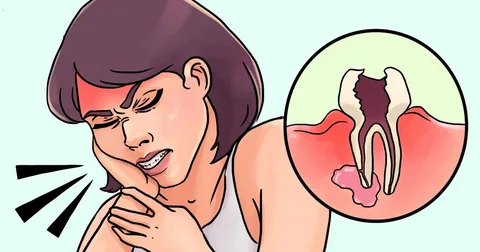Tooth pain can strike unexpectedly, often bringing a mix of sharp, throbbing, or constant discomfort that can disrupt your day. While nothing beats a visit to the dentist for professional care, there are several things you can do at home to manage tooth pain effectively. From temporary relief methods to understanding when it’s time to seek professional help, here’s a detailed guide on what to do when you experience tooth pain.
What to Do in Tooth Pain: Immediate Relief and Steps for Care
1. Rinse with Warm Saltwater
A saltwater rinse is one of the easiest and most effective remedies for tooth pain. It acts as a mild antiseptic that helps to cleanse the mouth, reduce inflammation, and ease discomfort caused by infection or irritation.
How to use:
- Dissolve a teaspoon of salt in a glass of warm water.
- Swish the solution around your mouth for 30 seconds.
- Spit it out and repeat a few times throughout the day.
Why it helps:
Saltwater can reduce swelling, disinfect the area, and flush out food particles, offering relief from mild pain.
2. Apply a Cold Compress
Cold therapy can numb the painful area and reduce inflammation. A cold compress works especially well for toothaches caused by swelling or injury.
How to use:
- Wrap a few ice cubes in a clean cloth or use a gel cold pack.
- Apply it to the outside of your cheek, near the painful tooth.
- Hold it there for 15-20 minutes and repeat as needed.
Why it helps:
Cold constricts blood vessels, reducing swelling and numbing the pain.
3. Use Over-the-Counter Pain Relievers
Over-the-counter medications like ibuprofen (Advil, Motrin) or acetaminophen (Tylenol) can provide immediate relief from tooth pain. These medications don’t treat the underlying issue but can help to manage discomfort temporarily.
How to use:
- Follow the instructions on the label for correct dosage.
- Take with food to avoid stomach irritation.
Important:
These medications help reduce pain and inflammation but should only be used as a short-term solution.
4. Apply Clove Oil
Clove oil contains eugenol, which has natural anesthetic properties that can numb the pain. It’s often used to temporarily relieve toothaches caused by cavities or gum irritation.
How to use:
- Dab a cotton ball or swab with a small amount of clove oil.
- Apply it directly to the affected tooth or gum area.
- Leave it on for a few minutes for relief.
Why it helps:
Eugenol in clove oil numbs the area, reducing pain temporarily.
5. Elevate Your Head While Sleeping
If your tooth pain gets worse when lying down, elevating your head can help reduce the pressure in your mouth and decrease pain. This can also prevent blood from pooling in your head and worsening the pain.
How to use:
- Use extra pillows to prop up your head while you sleep.
- Avoid lying completely flat as it may increase pain.
Why it helps:
Elevating your head reduces blood flow to the painful area and helps alleviate discomfort during sleep.
6. Avoid Triggering Foods and Drinks
Certain foods and drinks can exacerbate tooth pain, especially if the tooth is sensitive, decayed, or inflamed. Hot, cold, sweet, or acidic foods can irritate the tooth and increase pain.
Foods to avoid:
- Hot drinks and foods like coffee, tea, and soup.
- Cold items such as ice cream and chilled drinks.
- Acidic foods like citrus fruits or tomatoes.
- Sugary foods that can worsen tooth decay.
What to eat instead:
Opt for soft, room-temperature foods like mashed potatoes, yogurt, and smoothies that are less likely to irritate the tooth.
7. Visit a Dentist ASAP
While these home remedies can help manage the pain temporarily, it’s essential to see a dentist as soon as possible. Tooth pain is usually a symptom of an underlying issue, such as a cavity, gum infection, or abscess. A dentist will be able to diagnose the cause and provide the necessary treatment to prevent the problem from worsening.
Signs that you need to see a dentist immediately:
- Severe, throbbing pain that lasts for more than a couple of days.
- Pain that comes with swelling, pus, or fever (possible infection).
- Sensitivity to hot, cold, or sweet foods.
- Difficulty chewing or touching the affected area.
“These simple remedies provided me with much-needed relief from tooth pain. Quick, effective, and easy to follow—highly recommended!”satisfied client
The main purpose of exercise is to increase circulation and the intake of oxygen. This can be achieved by simple movement of the best spine and various joints of the body, with deep breathing, and without violent movement of the muscles.
Relief Today, Care Tomorrow
Tooth pain can be a frustrating and sometimes debilitating issue, but there are many effective home remedies to manage discomfort temporarily. From saltwater rinses and cold compresses to over-the-counter medications and clove oil, these steps can help ease the pain until you can see a dentist. However, it’s crucial to remember that home remedies only provide temporary relief. A dentist is your best resource for diagnosing and treating the root cause of your tooth pain, so don’t delay in seeking professional care!


Seeking Expert Advice for Tooth Pain Relief: What to Share with Your Dentist
- I’ve been experiencing consistent tooth pain for the past few days
- I’ve tried some home remedies like rinsing with saltwater, applying cold compresses, and using clove oil for relief.
- The pain has reduced slightly, but it hasn’t gone away completely
- I’m looking for a professional evaluation to identify the underlying cause and get proper treatment.
- Are there any other steps I should take in the meantime before my appointment?


12nssn